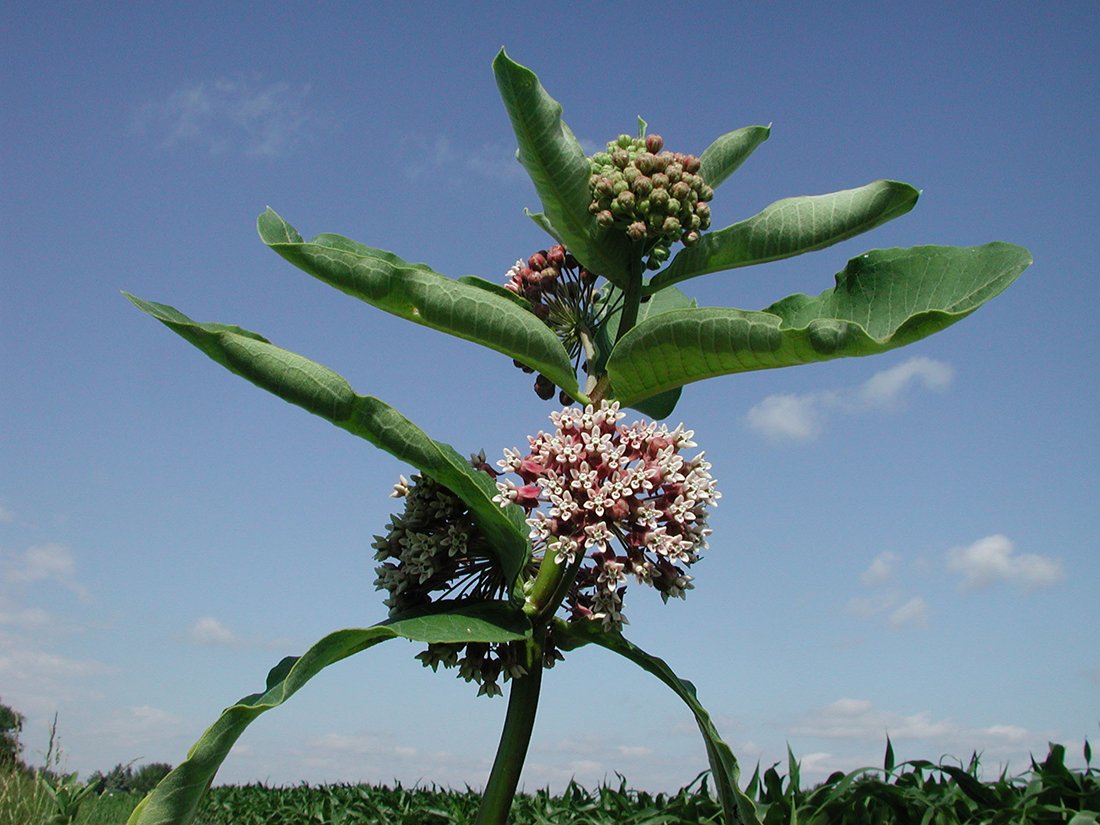Common Milkweed
- Milkweed family (Asclepiadaceae family):
- Asclepias syriaca L.
- EPPO code:
- ASCSY
- Other names:
- Silkweed, milkweed
Species information
- Lifecycle:
- Perennial.
- Propagation:
- Common milkweed reproduces by seed and horizontally spreading roots that produce new leafy stems.
- Emergence:
- The shoots emerge in May-June from underground root buds. After dispersal the seeds generally need a season before they germinate at a higher frequency. However, provided the soil temperature is warm enough common milkweed seeds can certainly germinate once dispersed. Seed has also been observed germinating after multiple years in storage.
- Habitat:
- Milkweed is found most frequently in open areas, especially along roadsides, fencerows and rivers, and in rangeland and cultivated fields. It is rarely found in woodlots and forested areas.
- Competitiveness:
- When competing with 12 milkweed shoots/m2 yield losses of 47% have been observed (Yenish and Durgan, 1997).
- Risk of Livestock Poisoning:
- Generally, the risk of livestock poisoning is low because milkweed is unpalatable and usually only consumed when no other preferred vegetation is available (Mitch, 1993). However, the primary toxins are cardiac glycosides that cause gastrointestinal, respiratory and cardiac problems that can lead to death if enough plant material is consumed (Shane, MSU). The toxicity of milkweed is not diminished when the plants are dried down (Shane, MSU).
Identification clues
Seedling
- Cotyledons:
- Oval.
- First leaves:
- Opposite and oblong, the first leaves of common milkweed are dark green, waxy and have a prominent white mid-vein.
- Mature leaves:
- Common milkweed’s mature leaves are similar to its younger leaves in terms of shape and mid-vein, but have more wavy margins and an underside that is densely hairy.
Mature plant
- Stems:
- The stem of common milkweed is erect, unbranched, hollow and covered in short hairs that resembles peach fuzz. The plant exudes a milky white juice when leaf petioles are torn off.
- Flowers:
- Common milkweed’s flowers have a round cluster of several five-petaled flowers that are pinkish white to purple. The flowers emit a pleasant fragrance and will eventually form teardrop shaped-seed pods.
- Seeds:
- Its seeds are brown, flat, oval and grow to be 6–10 mm long. The seeds are attached to a tuft of silky white hairs (fluff) that aids in wind dispersal with longer tufts of hair, which allow the seed to travel longer distances. In field trials with wind speeds gusting to 24 kph, milkweed seed traveled as far as 43 m.
- Roots:
- Common milkweed’s roots are thick and fleshy, white rhizomes that are very difficult to pull out of the soil. When pulled they often break.
Often mistaken for
I know it's not Hemp dogbane because milkweed has larger leaves, a green fuzzy stem and an erect unbranched stem, while hemp dogbane has smaller leaves, is branched, and has a reddish, hairless stem.





Updated: August 16, 2023
Published: January 13, 2023